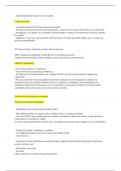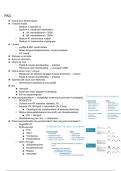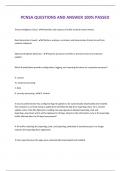CM2041
By Esmée Lieuw On
Course material: readings through Canvas
Cornelissen, J. (2017). Corporate communication: A guide to theory & practice (5th edition).
This summary includes:
Chapter 1, 2, 3, 4, 5, 8, , 9, 10, 11, 13
ESMEE LIEUW ON 1
, Week 1: Introductions
Chapter 1: Defining Corporate Communication
• There is a widespread belief in the management that in today’s society the future of any
company critically depends on how it is viewed by key stakeholders (ex. Shareholders,
investors, customers, employees)
• The objective of building, maintaining and protecting the company’s reputation is the core
task of corporate communication practitioners
• The best way to define corporate communication is to look at the way in which the function
has developed in companies
o 1970s: it was called ‘public relations’ whenever talked about communication with
stakeholders
o When other stakeholders, internal and external, started to demand more
information, the roots of the new corporate communication function came → new
specialized disciplines (ex. Corporate design, corporate advertising etc.)
o The new function focused on the organization as a whole and on the task of how an
organization presents itself to all its key stakeholders (internal/external)
o ‘Corporate’ refers to the business setting in which corporate communication
emerged as a separate function
▪ Originally stems from Latin word for ‘body’ (corpus) and for ‘forming into a
body’ (corporare) which emphasize a unified way of looking at internal and
external communication disciplines
▪ From the perspective of the organization as a single embodied entity
o In other words, corporate communication can be characterized as a management
function that is responsible for overseeing and coordinating the work done by
communication practitioners in different specialist disciplines such as media
relations, public affairs and internal communication
o Van Riel: “an instrument of management by means of which all consciously used
forms of internal and external communication are harmonized as effectively and
efficiently as possible”
o Objective: creating a favorable basis for relationships with groups upon which the
company is dependent
• Concepts and terms used in relation to corporate communication:
o Mission = the overriding purpose of the organization, which, ideally, is in line with
the values and expectations of major stakeholders and concerned with the scope and
boundaries of the organization
o Vision = desired future state, the aspiration of the organization
o Corporate objectives = statement of overall aims in line with the overall purpose
o cStrategy = the ways or means in which the corporate objectives are to be achieved
and put into effect
o Corporate identity = the profile and values communicated by an organization
o Corporate image = the immediate set of associations of an individual in response to
or more signals or messages from or about a particular organization at a single point
in time
ESMEE LIEUW ON 2
, o Corporate reputation = an individual’s collective representation of past images of an
organization established over time
o Stakeholder = any group/individual who can affect or is affected by the achievement
of the organization’s objectives
o Market = a defined group for whom a product is or may be in demand
o Communication = the tactics and media that are used to communicate with
internal/external groups
o Integration = the act of coordinating all communication so that the corporate
identity is effectively and consistently communicated to internal/external groups
• 1980s: a powerful restructuring trend in many corporate organizations where every function
in the organization was assessed based on its accountability and contribution to the
organization → more integrated departments/specific working practices and this proved
productive in that it offered direct organizational and managerial benefits
• Another drive for integrating communication at the organizational level was the realization
that communication generally had to be used more strategically to ‘position’ the
organization in the minds of potential stakeholders
ESMEE LIEUW ON 3





